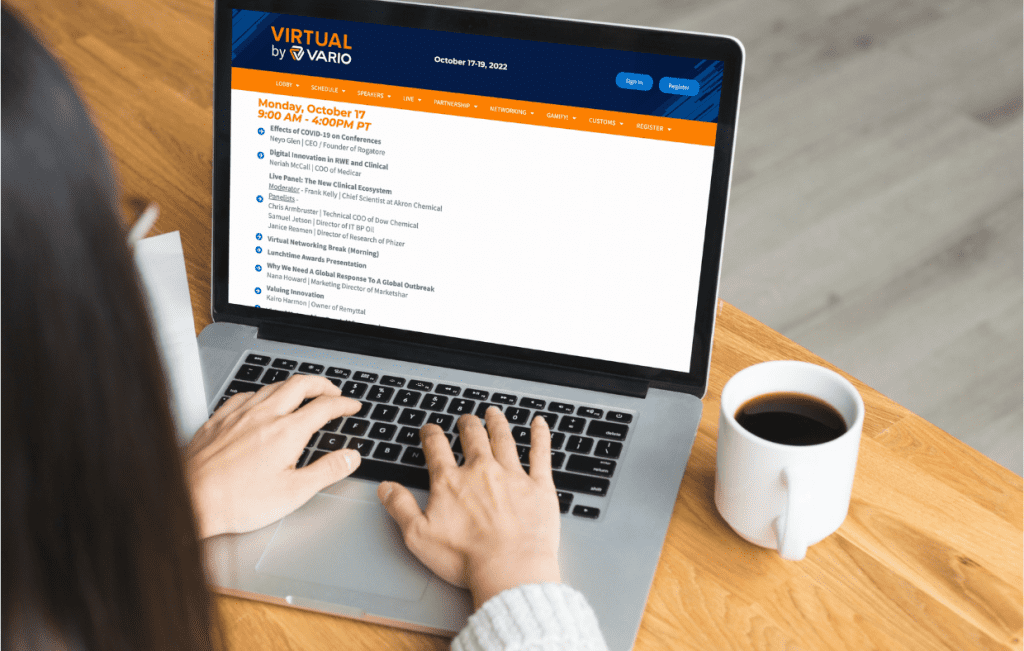How to Build Your Event Agenda
Before the curtain rises on your much-anticipated event, you’ll likely be a bundle of nerves hoping that everything goes smoothly. What can help this feeling is knowing that you’ve put the work in to plan the most effective agenda to meet your goals.
Whether you’re a rookie event planner or a veteran, you know that great events don’t create themselves. Rather, the hard work and dedication of event planners bring them to life. And because every event is unique, it can feel overwhelming when starting to plan a new event from the beginning unless you have a go-to game plan to help you along the way.
Read on for the ultimate how-to guide to crafting the perfect event schedule for your next event or meeting.
Determine the Event Format
Before you can begin putting together a schedule, you’ll need to determine the format of your event. These days, there are three primary options, and each comes with its own planning requirements:
- In-person – In-person events were standard before 2020. Where possible, this type of event can be more immersive and result in an enjoyable attendee experience with greater opportunities for networking. One thing to keep in mind for in-person events is that you will need to consult with your venue and production staff while building your event agenda. They can give you an idea of how much time it will take to set up the technology and staging required to bring your event to life. Knowing your setup and tear-down requirements is vital for making sure your event’s agenda is based in reality.
- Virtual – Virtual events existed well before 2020 but skyrocketed that year out of necessity. Most agree they are here to stay. It’s no surprise considering their convenience and affordability. But remember, even though your attendees no longer need to walk from room to room for things like breakout sessions and meals, you still need to factor in time for breaks and virtual production requirements as needed.
- Hybrid – Hybrid events are an exciting format that will continue to grow in popularity moving forward as they offer flexibility to provide both virtual and in-person experiences. However, be warned that you will need to plan 2 events: both an in-person and a virtual one. This means extra work on your plate. You will also need to work with your virtual production team to integrate the in-person and remote components seamlessly.
Identify the Event Content
Once you’ve solidified your event format, you’ll need to identify the content that will make up your meeting or event. Consider the following questions that can help you get started:
- Speakers
- How many will you have?
- How long will they speak?
- Breakout sessions
- How many will you have?
- How long will they last?
- Will they repeat?
- Meals and social hours
- How long is your overall event? Do you need to provide time for meals and breaks?
- Will you provide dedicated time for networking?
- Recorded content
- Should any elements of your meeting be recorded in advance?
- Will any of your content be made available for on-demand viewing post-event?
Consider Your Timing Requirements
Once you’ve identified the components that will make up your event, it’s time to come up with a timetable. Ideally, your agenda should strike the perfect balance between these different types of content.
For example, you might plan to provide breakout sessions immediately following the keynote speaker. Why? One of your main goals should be to create a positive event experience and you don’t want to overwhelm your audience with any one type of content. Providing variety in your schedule will keep your attendees engaged and focused.
Here are some best practices:
- Speakers – As you schedule speakers, you must determine how long each will present. It is helpful to organize content in digestible segments for your audience. Even if you think a speaker’s content is important enough to warrant a segment of over an hour, try to break up the content into smaller segments if possible. As always, you must know your unique audience and what they want but some studies show that most attendees today can lose attention after 20-30 minutes. Perhaps your speaker can talk for 20-30 minutes and then break for a section of Q&A before continuing their presentation.
- Content – How much content do you need to get through during your event? You’ll need to think about how early you’d like to start each day and how late you’ll have each day end. This is especially true if your event is spread over more than one day. Consider adding additional days to your program if your content would require you to start too early and/or end too late on any day. Just as any one session should account for short attention spans, each day should be planned for a reasonable length of time to keep attendees interested and not exhausted.
- Your Opening/Closing Sessions – The opening session of your event can make it or break it. You need to get your attendees excited for what is coming. Similarly, you need to plan for a closing session that will wrap up your content and keep your attendees talking about your event long after it has concluded.
- Your Audience – Also consider where your attendees are coming from and account for your audience’s geographic movements. If they are traveling internationally or from across the country, consider easing them into the event and creating a pleasant experience as they adjust to a new time zone – happy hours or welcome receptions work great for this purpose. Will you need to accommodate multiple time zones? If you’re planning an online event, choose a reasonable hour for all time zones or offer the sessions to be available on-demand post-event.
- Pre-event – If you do choose to have a welcome reception before the first day of the event, consider that many attendees might have just spent all day traveling and will be hungry and tired. This can affect the type of refreshments you serve and the length of the get-together.
- Breaks – Ideally your content should allow you to schedule breaks about every 90 minutes to keep event-goers focused and fresh. This goes for all event formats—while virtual event attendees can turn off their cameras to get snacks if they need to, regular, scheduled breaks will help deepen their engagement. Remember the days of waiting for commercial breaks to walk away from the TV for snacks or to head to the bathroom? It’s just like that. Attendees will stay more focused during your content because they know breaks will be available at reasonable intervals.
- Lunch – As you figure out the timing for everything else, consider whether or not you will provide a break for lunch. Will lunch be offered as part of the meeting or will guests need to leave the facility to get their meal on their own? These two options will affect the actual length you’ll need to provide for a lunch break.
Organize Your Event Sessions
Once you’ve determined the content of your event and went through all of the timing considerations, it’s time to organize the event sessions and write your agenda! To write the event agenda, you will include all relevant information for each session, such as the topic, speaker, location, and timing.
Each session should be sorted based on three categories:
- Session topic – Consider how you will group session topics. For example, will similar topics run at the same time, in succession, or on separate days? The session topics should be somewhat sequential, meaning that earlier sessions will give attendees any necessary background information they need to understand subsequent sessions.
- Session time – For larger-scale events, you might organize multiple sessions simultaneously for attendees to choose from. You may also want to repeat sessions if you’d like for your attendees to have the best chance of viewing the content that is of interest to them. In this case, you may wish to keep sessions shorter (30-50 minutes).
- Session location – The session location is an important consideration. For events held in larger spaces, guests will need time to move between locations as they attend different sessions. If possible, group sessions that are in the same track near each other. Breaks can be short but ideally, attendees should have enough time to use the restroom and/or get water or snacks and still make it to their next session before it begins.
As you build the event schedule, incorporate both tracks and tags to keep the event organized and streamlined for attendees. If you’re not already aware:
- Tracks – Tracks follow a specific theme and include various sessions or activities under their umbrella. For example, a conference for event planners might have multiple tracks, and each track could involve topics for a different type of event such as “virtual”, “in-person” or “hybrid”. Organizing sessions within each track helps attendees understand where to go and ensures you won’t double book sessions with overlapping topics.
- Tags – Much like hashtags, tags are keywords that you can add to sessions so that attendees know which specific topics or ideas the session will relate to. As with tracks, they help attendees choose between sessions. For example, a track at an event planners’ conference might be “virtual events,” but tags for a session within that track would be more specific and specialized such as “budgeting/finances” or “technology”.
Whether or not you incorporate specific tracks or tags into your event, the point is that you must organize your content in such a way that your attendees can easily identify and sort through sessions to choose which to attend.
Invest in an Agenda-Building Tool and/or Event App
As you scale your events up in size, you will quickly realize that the right technological support makes all of the difference. Many event planners find agenda-building tools to be invaluable. There are a wide variety of programs that can make this process easier for you.
Similarly, an event app can make both your team’s and your attendees’ lives easier. If you have the budget, using an event app to integrate your registration information, ticketing software, agenda and schedule will streamline your planning and event.
As you shop around, consider not only price but functionality. The program should be seamless for both you and your attendees. You will want it to be easy for you to create the agenda and to collect data. Attendees will prefer an all-encompassing program so that they don’t have to switch between different apps or websites to obtain information about the event.
Other Tips for a Successful Event
Hopefully, you’re beginning to have a good understanding of what you need to evaluate to build your event agenda. Here are a few more important considerations:
- Incorporate sponsors – You can mention sponsors in event sessions by including their logos in the event agenda and by adding specific call-outs to establish your organization’s relationship with them. Another great way to highlight sponsors is to have them host a reception, meal or break.
- Finish with a happy hour or networking session – Ending each day or the event itself with a happy hour or networking session is the perfect way to say goodbye to attendees. They can unwind and exchange information before they depart.
Before the Curtain Falls
As you can see, there are many factors that can help you craft the best event for your goals. Making a good event schedule is all about preparation and balance. Preparation allows you to plan for anything and everything that can occur during the event. Balance will enable you to prioritize both the content you want to present in your sessions and the guest experience you want to build through considerations such as breaks and networking opportunities.
It’s easy to get overwhelmed by all of the competing interests that you need to balance but we hope this guide has helped you to start strong. If you’re wishing for a helping hand, we’re happy to be your partners. With over 20 years of experience in the event planning space, we offer strategic services to help plan your event from A to Z. For more information, contact us today.
Sources:
Zoom. Zoom Video Webinars. https://explore.zoom.us/en/products/webinar/
American Planning Association. Tracks. https://www.planning.org/conference/tracks/







